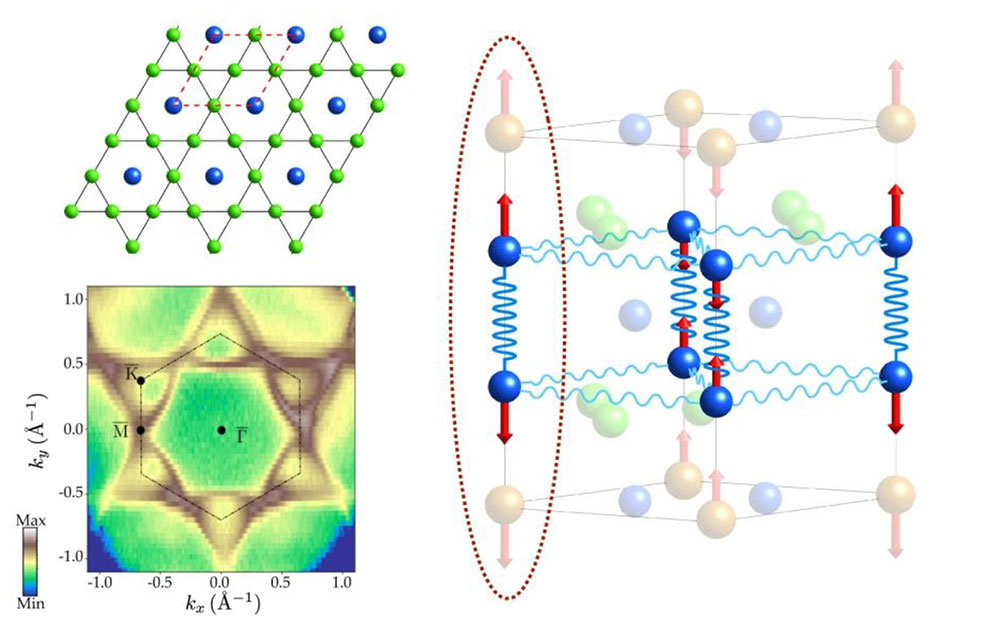Scientists Study Atomic Vibrations in a Kagome Metal
Investigating the electronic behavior and lattice dynamics in ScV6Sn6
January 23, 2024
 enlarge
enlarge
Top left: Top view of the kagome net. Green and blue balls denote the V and trigonal Sn atoms, respectively. Red dashed lines mark the unit cell. Bottom left: Fermi surface map of ScV6Sn6. Right: Vibrations of the phonon mode between coupled trigonal Sn atoms. Image credit: A. Korshunov, H. Hu, D. Subires, Y. Jiang, D. Calugaru, X. Feng, A. Rajapitamahuni, C. Yi, S. Roychowdhury, M.G. Vergniory, J. Strempfer, C. Shekhar, E. Vescovo, D. Chernyshov, A.H. Said, A. Bosak, C. Felser, B.A. Bernevig, S. Blanco-Canosa, Nat Commun 14, 6646 (2023)
The Science
Scientists demonstrate the softening of phonons (vibrations) in the atomic lattice of the kagome metal ScV6Sn6 and explain this phenomenon.
The Impact
The hexagonal lattices that characterize kagome metals carry ordered electronic phases, such as charge density waves (CDWs), which give them potential as quantum materials. But researchers must first study the complex interplay between these phases, phonons, and the metal’s lattice geometry.
Summary
Kagome metals, also referred to as kagomes, are a class of compounds characterized by atomic lattices with hexagonal geometries that give rise to very complex electronic band structures. They are named after their resemblance to the woven pattern of traditional Japanese kagome baskets, which consists of corner-sharing triangles that form hexagons. The kagomes have become a rich testing ground for studies that aim to explore the relationship between a material’s electronic band structure topology and its resulting physical behaviors.
If kagome metals could be engineered and tuned, they could form the basis of new advanced materials, including quantum materials. But scientists first must gain a greater understanding of how their electronic and magnetic properties, along with lattice geometry and vibrations, are intertwined.
One of the studied features in the kagome metals is an ordered arrangement of electrons called a charge density wave (CDW), which arises at a particular transition temperature. Recently, a CDW with unconventional features was detected in the kagome ScV6Sn6, a compound of scandium, vanadium, and tin (dubbed SVS). SVS, like all kagomes, has a layered crystal structure, with V atoms and Sn atoms making up the “kagome net,” which has a geometry of hexagons and triangles.
The nature of the CDW detected in SVS has intrigued both materials scientists and physicists. Additional studies showed that lattice instabilities in SVS, particularly vibrations (phonons) from the Sc and Sn atoms, are related to its unusual CDW behavior, but couldn’t reveal additional details.
Recently, a team of researchers shed further light on the relationship between the CDW and the lattice vibrations in SVS. They used a variety of experimental and theoretical approaches, including an x-ray technique called angle-resolved photoemission spectroscopy (ARPES), performed at the Electron Spectro-Microscopy (ESM) beamline at the National Synchrotron Light Source II (NSLS-II). NSLS-II is a U.S. Department of Energy (DOE) Office of Science User Facility located at DOE’s Brookhaven National Laboratory.
Their results show a softening, or reduction in energy/frequency, of low-energy longitudinal phonons in one particular plane of the atomic lattice. This happens just as a CDW is emerging. The collapse of the phonon mode—the first such reported instance—is marked by an out-of-plane vibration of the Sc atoms and the trigonal Sn atoms. This data suggest that the kagomes – 166 compounds in total – are excellent candidates for the exploration of the role of phonons in the physics of electronic band structures.
Download the research summary slide (PDF)
Contact
Bogdan A. Bernevig
Princeton University
bernevig@princeton.edu
Santiago Blanco Canosa
Donostia International Physics Center
sblanco@dipc.org
Publication
A. Korshunov, H. Hu, D. Subires, Y. Jiang, D. Calugaru, X. Feng, A. Rajapitamahuni, C. Yi, S. Roychowdhury, M. Vergniory, J. Strempfer, C. Shekhar, E. Vescovo, D. Chernyshov, A. H. Said, A. Bosak, C. Felser, B. Bernevig, S. Blanco-Canosa. Softening of a flat phonon mode in the kagome ScV6Sn6. Nat Commun 14, 6646 (2023). https://doi.org/10.1038/s41467-023-42186-6
Funding
D.S. and S.B.-C. acknowledge financial support from the MINECO of Spain through the project PID2021-122609NB-C21 and by MCIN and by the European Union Next Generation EU/PRTR-C17.I1, as well as by IKUR Strategy under the collaboration agreement between
Ikerbasque Foundation and DIPC on behalf of the Department of Education of the Basque Government. H.H. was supported by the European Research Council (ERC) under the European Union’s Horizon 2020 research and innovation program (Grant Agreement No. 101020833). D.Cal. acknowledges the hospitality of the Donostia International Physics Center, at which this work was carried out. D.Ca. and B.A.B. were supported by the European Research Council (ERC) under the European Union’s Horizon 2020 research and innovation program (grant agreement no. 101020833) and by the Simons Investigator Grant No. 404513, the Gordon and Betty Moore Foundation through Grant No.GBMF8685 towards the Princeton theory program, the Gordon and Betty Moore Foundation’s EPiQS Initiative (Grant No. GBMF11070), Office of Naval Research (ONR Grant No. N00014-20-1-2303), Global Collaborative Network Grant at Princeton University, BSF Israel US foundation No. 2018226, NSF-MERSEC (Grant No. MERSEC DMR 2011750). B.A.B. and C.F. are also part of the SuperC collaboration. C.F. acknowledges funding from the Deutsche Forschungsgemeinschaft (DFG, German Research Foundation) for 5249 (QUAST), the Deutsche Forschungsgemeinschaft (DFG) under SFB1143 (project no. 247310070) and the Würzburg-Dresden Cluster of Excellence on Complexity and Topology in Quantum Matter—ct.qmat (EXC 2147, project no. 390858490). This research used resources of the Advanced Photon Source, a U.S. Department of Energy (DOE) Office of Science user facility operated for the DOE Office of Science by Argonne National Laboratory under Contract No. DE-AC02-06CH11357. The research at the Electron Spectro Microscopy beamline (ESM-21ID) of the National Synchrotron Light Source II is supported by the U.S. Department of Energy (DOE) Office of Science User Facility, operated for the DOE Office of Science by Brookhaven National Laboratory under Contract No. DE-SC0012704.
2024-21687 | INT/EXT | Newsroom









